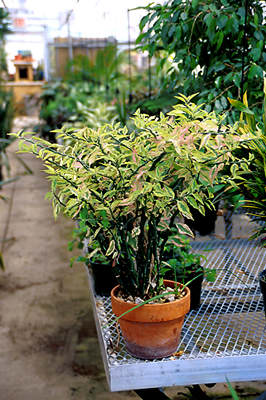

The leaves on these medium green stems are at the center of each zigzag. Is The Zig Zag Plant A Succulent?īecause of its zigzag shape, this houseplant ( euphorbia tithymaloides ‘Variegatus’) is a good choice for a garden. Is Zig Zag Plant An Indoor Plant?Ĭredit: I am not sure about zig zag plant specifically, but most plants need sunlight to grow, so an indoor plant is not ideal.

Even in direct sunlight, keep plants in good lighting. You will be able to grow the plant by increasing the amount of water and feeding it every three to four weeks. When it comes to the winter months, it is critical to provide as much bright light as possible and to water only sparingly. Devil’s backbone plants, unlike many other types of plants, do not require fertilizer. Because it has sedative properties, it can also be used in patients with psychiatric illnesses such as schizophrenia and panic attacks. ( Pedilanthus tithymaloides) is a spurge family member, known as a devil’s backbone or shoe flower, in English.ĭevil’s backbone ( euphorbia characias) is a plant known for its broad range of medicinal properties, including inflammatory and infectious diseases, diarrhea, fever, cough, and wound healing. Place the callused end in a low- soil medium, such as a peat moss mixture, as directed. Prune the zig-zag plant during the summer, but wait until the flowers have faded before doing so.įresh cuts should be allowed to call out for a few days after they have been prepared. The plant is suitable for desert landscapes because it tolerates drought well, which is uncommon among tropical plants. Devil’s Backbone plants are very easy to grow and will thrive in a variety of growing conditions. sap has the potential to cause pain and redness in your eyes. Consuming this toxin can cause vomiting and diarrhea. A medication known as cardiac glycosides is commonly used by dogs with heart problems. The Devil’s backbone plant contains a cardiac glycoside toxin known as bufadienolides.
#Rooting zigzag plant skin
It is not necessary to touch the milky sap of the plant due to skin irritation, but you can still taste the green leaves if you are not too scared. There are no safe ways to eat the devil’s backbone plant, and all of its parts can be toxic to pets and humans. It should not be left near children or pets, and should be washed or handled with gloves if necessary. Dana Royer, leaves have jagged, pointy edges that are packed with xylem, which transports water and nutrients from sap.ĭespite its drought-tolerant foliage, ZZ plants contain poisonous parts and make a great addition to low-light situations in homes and offices. The best way to propagate your cacti is to use water or a potting mix. It is relatively simple to cultivate a fishbone cactus.

The stems of devil’s backbone produce interesting patterns as they grow, earning them the name. Red flowers, which can reach 1cm long and up to 1 cm across, cluster around the stems in clusters. Before planting, the plant should be grown in a terra-cotta pot with well-draining sandy soil, and it should be allowed to become root-bound before transplanting. The zigzag plant (Eucphorbia tithymaloides ‘Variegatus’) is a succulent spurge with a distinctive shape and is a fun houseplant. Ingesting the plant can cause stomach upset. While the plant is not deadly, it can cause irritation and swelling if it comes into contact with skin. However, some people may be surprised to learn that this plant is actually poisonous. The zigzag plant, or Tradescantia fluminensis, is a common houseplant that is known for its easy care and colorful leaves.


 0 kommentar(er)
0 kommentar(er)
